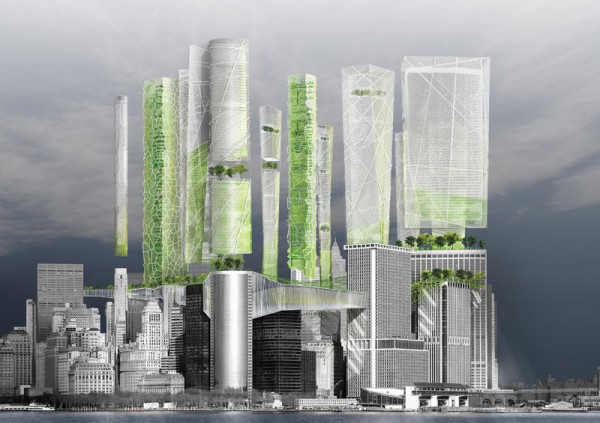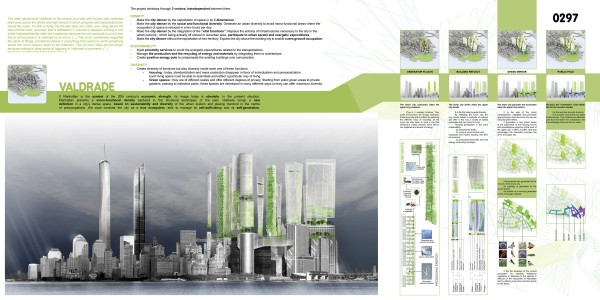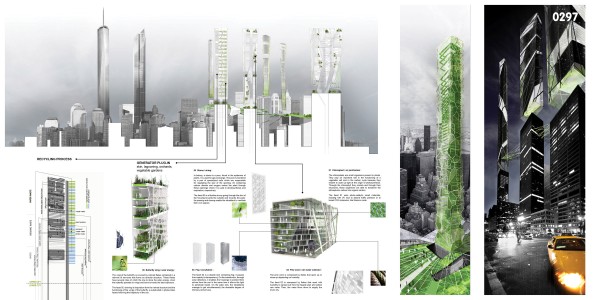Special Mention
2010 Skyscraper Competition
Metamorphose
Axel Cailteux, Céline Hautfenne, Julie Neuwels, Delphine Termote
Belgium
Valdrade brings a new definition of a city dense space, based on 3 interdependent vectors: density, sustainability and diversity. We must consider the city as a true ecosystem, able to manage its self-sufficiency and its self-generation.Valdrade expands as an “upper city” above the existing “lower city” to enable a zero ground occupation and to compensate the deficiencies.
The lower city consumes whereas the upper city produces by the plug-in of self-sufficiency generators. So the entirety of the infrastructures, necessary to the city life, is replaced in the urban network. These infrastructures are currently off shored in suburban areas, participating to the urban sprawl and energetic expenditures. These plug-in create positive energy poles to compensate the current buildings over-consumption. They provide different ways of recycling, so that the whole cycle can slide back, in such a way that someone’s wastes become some other’s raw materials and sources of energy.
The self-sufficiency generators propose a photovoltaic skin and wind turbines for the electricity production, lagooning for the waste water purification and recycling area for the organic and paper waste recycling and production of recycled paper, compost and gas by methanization.
The lower city works while the upper city dwells by creating a “housing reflect” of the existing towers. It is the first step towards diversity. By reflecting the lower city, the new towers adopt a multitude of outlines and offer a variety of spatial typologies and new ways of living.
The lower city parasites the ecosystem while the upper city feeds it by drawing a green vegetable and permeable layer between the two cities. It generates a new public space at the basements of the housing towers and re-establishes proximity at the level of the upper city while it offers a buffer zone between the two cities. It shelters and feeds the local fauna by offering it a flora in adequacy with its needs.
Then, by place, the “in-between cities” dilates, to offer new public infrastructures and get further in the urban diversity. They act as a new attraction pole that stimulates connections, exchanges and synergy between the two cities.
The facades are double smart skins composed from facets reacting with their environment. Each facet takes its inspiration from a natural element which ways of working fit with the uses and the aims of the skin.
Facet 01 is inspired from chloroplast cells in order to purify the city’s air, by using photo-catalytic smart materials, reacting to UV rays for absorbing traffic pollution or breaking CO2 molecule.
Facet 02, composed by flakes reacting to humidity and spreading out from the façade plan, acts like a pine cone to collect rain water.
Facet 03, as the stoma found in the epidermis of plants and used for gas exchange, is a flexible airway, going through the skin of the housing. Its opening and closing enable the inhabitants to ventilate their own spaces.
Facet 04 is a double skin containing fog, changing from opacity to transparency. On the outside skin, it enables the housings to protect them from the sun at the same time as it allows the light to penetrate inside. On the patio skin, the inhabitants manage to simultaneously get the desirable degree of intimacy and privacy.
Facet 05, drawing its inspiration from the veined structure and the functioning of the butterfly’s wings, is composed of photovoltaic facets following the trajectory of the sun.

















